
Speak Up: For those unfamiliar
with you or your current doings a monograph of your work, It is Beautiful…
Then Gone, was recently released. How did you go about developing this book
and why produce it now? Kenneth Fitzgerald and some other design critics feel
monographs are… well, over. Would you even define your book as a conventional
monograph?
Martin Venezky: I had originally approached Clare Jacobsen at Princeton
Architectural Press with the hopes of developing a book about the Form class
I had been teaching in San Francisco. In the process, I presented my
portfolio hoping that, if the Form book didn't pan out I might at least get
a design project from them. In the midst of that interview, Clare surprised
me with the suggestion of a monograph of my work. It took me a while to put
a serious proposal together, and then a couple of years to actually produce
the book.
I was familiar with the critical exhaustion over the monograph deluge, so I felt
a lot of pressure to make the book worth the public’s time and money. That’s
why I tried to treat the book as a laboratory rather than a gallery – showing
studies, sketches, works in progress alongside finished pieces. How does one’s
life infiltrate one’s work and how does one’s work shape one’s
life? This was a question the book attempts to answer.
When a monograph is published it usually announces the completion of a body of
work and the start of a new phase. My move from San Francisco to Providence coincided
with the book’s writing and production. And its publication coincides with
my arrival in Los Angeles. I can’t help but think that my work will also
be shifting, but I can’t yet tell in what direction.

|
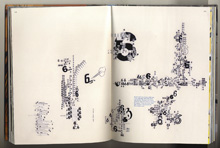 |
|
How does one’s
life infiltrate one’s work and how does one’s work shape one’s
life? This was a question the book attempts to answer.
|
|

SU: I find it interesting that you refer to the book as a Laboratory. Could you expand on that a bit?
MV: The book presents work in a messy, unfinished and rejected state as well as finished product. The quantity of material is akin to opening drawers and dumping them out rather than hanging pictures on a wall. A laboratory is a place built around process.
SU: Many would call your approach "experimental." Do you believe this is a
fair appraisal?
MV: The term “experimental”
is often used as a code for unusable, weird, “crazy” or “going
wild”. But I think that is a big misunderstanding, and something I try hard
to correct in the classroom. When I teach an experimental class, I am quick to
explain that experimentation is a methodology.
SU: What do you think is being implied by that?
MV: It suggests a circular set
of steps: setting up an experiment, running the process, analyzing the results
and then letting the results guide the next experiment. There is no external aesthetic
to experimental work. It is as much about setting criteria and using them to analyze
results as it is about the producing of the material. Far from “going wild”,
it is a very rigorous exercise that allows a designer to confidently engage in
work whose results are unpredictable. So, yes, I think that a lot of my work is
experimental, but not in the ways that most define it.
SU: Are you familiar with
Denise Gonzales Crisp’s piece of writing called “Toward a Definition
of the Decorational”?

|
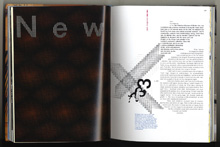 |
|
The term “experimental”
is often used as a code for unusable, weird, “crazy” or “going
wild”. When I teach an experimental class, I am quick to
explain that experimentation is a methodology.
|
|

MV: Yes of course. Together,
Denise and I put the original terms together. I had been considering a group of
designers as “decorationists” and she refined the term to the more
astute “decorationalists.”
SU: Any thoughts on decoration?
MV: I think that decoration,
for its pure visual stimulation and wonder, is a fantastic thing. Our response
to it is part of being human. Pattern, variation, texture, color, qualities of
light and shadow, figure and ground – all of these things produce sensations
in us that are based more on biology than rationality. The elevating of engineering
to an aesthetic ideal is based on the purity of rational and mathematical thought.
The merging of the two – or perhaps the resonance between the two –
can create a deep engagement. Architects and composers have known this for ages.
Designers seem to be forever struggling with the notion. The two worlds clash
throughout culture and history. It is a classic contest between the (emotional)
warrior and the (rational) lawyer.
SU: One of my favorite quotes:
“I am alone in my laboratory, examining what I know, holding it up to existing
knowledge. I am working on my experiments, a bit mad in this way, insulated. Not
unlike Le Corbusier who in 1925 asserted that ‘we have now identified decorative
art as commensurate with the art of the engineer’”.
The name of your firm is Appetite Engineers. And in <em>It is beautiful...</em>
Karen A. Levine’s essay about you is entitled, “Martin Venezky, Engineer”.
Does Ms. Crisp quoting Le Corbusier in her lab resonate with you? Are you a mad
scientist in your studio, or simply an engineer?
MV: Well, first I don't think
that Le Corbusier would have put the term “simply” in front of engineer.
I think he was suggesting that the pinnacle of decoration (in his age) was the
perfectly engineered product.
SU: You mentioned composers,
but at one point in It is Beautiful... you recall your time as a club
DJ and you liken the designer’s role to that of a musical DJ.
MV: The DJ anecdote highlighted the importance of transition and
juxtaposition in how we understand and react to the world. That kind of
attention is always rotating heavily in my mind! The physical discipline to
work slowly, by hand, with acute attention is also big on my playlist.
SU: It seems you are drawn
to slow processes. In your book you mention that you “use a lot of primitive
technologies to make things more difficult for myself” and that your “favorite
process are gradual and meticulous.” Why is slower better?
MV: Well, I can only say that
it’s better for me. I’m always amused at the training of designers
to be efficient in arriving at their “solutions.” To my mind there
is absolutely nothing intrinsically efficient about design. That is based on a
business model, which is fine as far as it goes, but it is a mistake to pretend
otherwise.
There are times when I wonder why design departments bother to attach
themselves to art schools, when, at least for some of them, it would make
more sense to be housed within a business school.
Yes, it is wise for designers to be efficient when having to produce work
for a client who has a deadline or budget. But by doing so, several worlds
of possibilities are sliced away. What is the solution? Well, perhaps the
solution is to either stay poor or stay busy. That is, to put the hours into
the work until it is realized regardless of any monetary exchange. That may
mean avoiding deadlines or working all through the night or never getting
paid for the hours you pour into your work. But what's fundamentally wrong
with that?
For me, I am efficient when I have to be, and inefficient when I am afforded
the chance. Slowing down the process allows me to discover the meandering
qualities within the work and pursue them for a while. When I work on a
collage piece, I force myself to make a decision about the placement of each
and every element, one at a time. Yes it is a luxury, but there is so much
pleasure in the attempt to control and the relinquishing of that very
control to the demands of the piece.

|
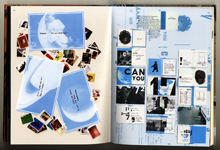 |
|
To my mind there
is absolutely nothing intrinsically efficient about design. That is based on a
business model, which is fine as far as it goes, but it is a mistake to pretend
otherwise.
|
|

SU: If it’s not just
about the gestational speed of your working methods, it’s often about the
physicality of them. Why is materiality so important to you?
MV: Because I’m a human
being and human beings seem to like to hold real things in their real hands.
SU: And like to learn from
other human beings. You’ve devoted an entire section to teaching in your
book. Here is a bit of a Chicken and Egg riddle: What is the relationship of your
practice to your teaching methodology? Does your unique way of working inspire
lessons and pedagogy, or does working with students influence your own projects?
MV: The way I make things is a result of the way I interact with the world,
in all its eccentricity. And the way I teach is a result of the way I make
things, in all of its stubborn (though not ineffective) abnormality. The
classroom forces me to articulate my point of view, my opinions, my process.
I must develop a persuasive argument in my own defense. But that very
articulation changes me by nudging me towards self reflection and criticism.
And that then changes my interaction with the world and its reflection in my
work.
SU: Early in your book you
say that you, “search for an internal logic within the work. That logic
may become more complex or turn in on itself. But it is no more random than a
twisting vine.” I have seen the term “internal logic” used to
talk about postmodern sculpture by Rosalind Krauss, Andrew Blauvelt suggests it
in his Emigre rant on critical autonomy, and in the follow up Emigre issue Experimental
Jet Set says: “In our view, design should have a certain autonomy, an inner
logic that exists independently of the tastes and trends of so-called target audiences.”
What do you mean by internal logic?
MV: It is the same internal
logic that feeds the other arts – film, writing, music, drama, painting.
In each case it seems that the role of the creator is an attempt to create a piece
that seems to have created itself. It’s like developing a machinery that
generates the entire work. A writer or dramatist may craft a series of characters
and a basic premise and then set them loose. The characters and the premise might
be absurd when compared to an external logic. But within the world that has been
created, it all makes sense.
This is not an easy thing. That’s why there is an awful lot of bad music
and bad film. Contrivance has a way of creeping out of the seams of an imperfect
work. Effortlessness takes an enormous amount of effort. This is the part that
is so often missed, especially when discussing “intuitive” work. The
best intuitive work seems to be a result of immense preparation and development,
and comes from a source of confidence, not simply “anything goes.”
SU: You said that the Classroom forces you to develop a persuasive
argument in your own defense. What is your defense for those that say your
work is simply expressionistic, or that your work is empty form grafted on
to content? And is there anything wrong with that anyways?
MV: One could say that abut
the Dwiggins’ book covers, or Mueller-Brockmann’s music posters. Anywhere
that abstraction is involved is territory for that sort of argument. Decoration
is often empty form that surrounds content.
But is form ever really empty? Even the most abstract pattern involves sensation
that causes a reaction (see earlier answer). The meaning may not be specific,
but that seems to be a weak reason to discard it. What is the meaning in the pattern
and color and material of the clothes we wear or the bedding and drapes we buy?
Isn’t that empty form, too? But it is all design and causes very definite
reactions in us. We just seem to be unwilling to readily accept those reactions
in graphic design.
(The book, and the extensive writing in it is an attempt to answer some of
those arguments. )

|
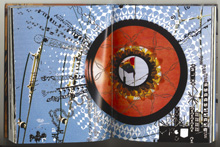 |
|
The
best intuitive work seems to be a result of immense preparation and development,
and comes from a source of confidence, not simply “anything goes.”
|
|

SU: In “Thoughts on
the Classroom” you seem to be saying that your teaching and practice, and
process, it all seems to come back to a certain kind of physicality. Is this the
thread that ties together, thinking, making, teaching for you? What is the importance
of tangibility?
MV: Yes, tangibility is a result of my experimenting with materials and their
reproduction.
SU: Are their other threads I, or others might miss?
MV: Other threads, which I discuss
in the book involve the emotions of melancholy and sentimentality, which affect
me very much. They don’t always come through in the subject matter, but
often in the fragility and decay of the materials and construction.
SU: What about your own educaiton? In the brief section on your work at Cranbrook you mention that you were actually admitted ten years before you decided to reapply and attend. What did you learn in that decade between admissions? And how did you know you were ready for graduate work?
MV: When I first applied I was
very young — just out of my undergraduate work. Kathy McCoy thought I might be
too young and unread to get the most out of my time. So, although I was accepted,
it was with expectation that I would need to catch up before I arrived in Michigan.
At the time, I felt that my energies would be better spent in the working world.
For years hence I considered that the worst decision of my career, and regretted
it with every dopey “20 cents off” coupon I had to design.
A few years after moving to San Francisco in 1985, I began seeing a
developing new world of graphic design: Rudy Vanderlans, David Carson, and
young San Francisco designers like Steve Tolleson, Jennifer Morla and
Lucille Tenazas were all rising stars. Try as I might, I could not bridge
the chasm between what I was doing (at the time I was working in the design
department of a marketing firm) and what I was witnessing.
On one especially despondent night, it suddenly hit me. Perhaps it wasn’t
too late for me to apply. Even though I was thirty-three, maybe my career wasn’t
beyond repair. Rarely have I had a moment of such lucid revelation. I was literally
jolted awake. It’s hard to believe that I hadn’t thought of this earlier,
but I suppose it was simply the right time. The next morning I called Cranbrook
and meekly asked if they accept older students. I was reassured and began the
process.
But it wasn’t easy. My portfolio had deteriorated into a series of glossy
sales kits for food merchandisers, and that was not enough to gain entrance the
second time I applied. But by then I was absolutely determined. I took night classes
in typography and weekend workshops in design. (I had actually never taken a design
class before this – my schooling was in fine art). I worked during the day
in Oakland and then drove down to Santa Clara for the classes. I met Lucille Tenazas
when I attended one of her weekend workshops. She was generous with her time and
encouraging with her advice and recommendations. By the skin of my teeth I got
into Cranbrook on my third try.

|
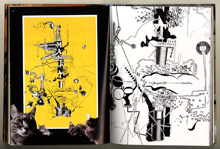 |
|
My portfolio had deteriorated into a series of glossy
sales kits for food merchandisers, and that was not enough to gain entrance the
second time I applied. But by then I was absolutely determined.
|
|

SU: How can any designer know
they’re ready?
MV: If you are ready and open, the right graduate program can change your life.
You begin to see design in terms beyond a profession, but as a way of
examining the world. Once you develop the tools of investigation, everything
becomes so much more curious, and you can see your own work as a response to
that curiosity.
SU: In an essay Katherine
McCoy wrote in Steven Heller’s The Education of a Graphic Designer (1998)
she closes with this paragraph: “Emotion, subjective interpretation, and
hand gestures are what humans can contribute and computer’s expert systems
can not. Highly technological societies will likely put a premium on subjective
human values. This suggests the possibility of a renewed appreciation and new
applications of our earlier, intuitive, image-oriented, and generated design approaches.
Design as a cultural activity, including aesthetic and personal expression, may
be the essential source of values, emotions, and play that we all need in the
digital domain.”
The Mcoy’s were the designers in residence when you where at Cranbrook,
and left shortly after you did, three years before this was written. Does this
sound like something Kathy would have said to you while you were her student?
If so it is easy to see how this way of thinking has influenced your process and
your way of thinking about physicality and materiality that you mentioned earlier.
MV: In 1991, the computer was
not yet seen as a limitation. It was a transitional period and the computer was
still an awkward instrument (or at least we students were awkward operators).
No world wide web, no emails, just the very beginnings of color printouts (and
expensive beginnings at that)… So technology’s chipping away at subjective
human values was not yet apparent. We were just trying to keep our damn Syquest
disks from crashing!
I turned back to handwork because that was how I had been working for
years. My formative years were based on wax, rubber cement, and parallel
rules. So it was less a response to the coldness of the computer and more a
safety zone where I felt I could control and express things more
efficiently.
Kathy was (and still is) an influence on me, but not in the obvious ways
this statement might suggest. During my time at Cranbrook, she never
preached one kind of design, or one methodology over any other. Her skill
was more personal. For me it was seeing a direction I was too comfortable
with (using vernacular imagery in a smart-alecky cold way) and challenging
me to tackle its direct opposite (replacing it with something painfully
personal). Those kinds of engagements are far more powerful than manifestos.
SU: Thank you Martin.

This interview has been conducted exclusively for Speak Up.
Reproduction without our written consent is strictly prohibited. Please if you would like to use it for educational purposes or if you are interested in other means of reproduction. Thank you for your understanding.






